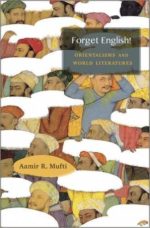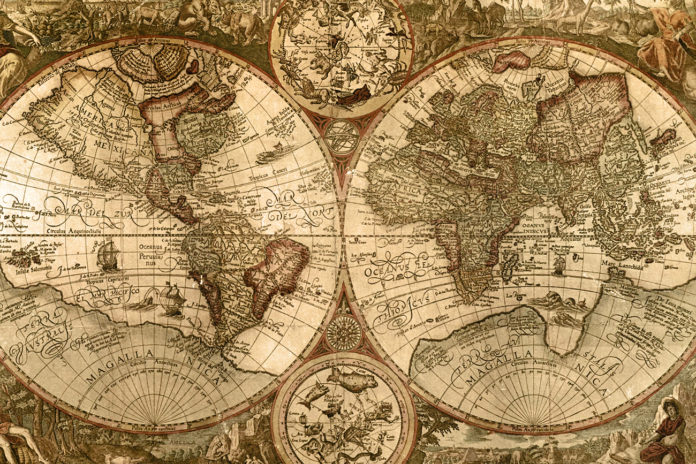 Aamir R. Mufti: Forget English! Orientalisms and World Literatures (Harvard University Press, 2016)
Aamir R. Mufti: Forget English! Orientalisms and World Literatures (Harvard University Press, 2016)
Reviewed by Vassilis Lambropoulos
This essay was peer-reviewed by the editorial board of b2o: an online journal.
Aamir Mufti’s Forget English! exposes the regulatory operations of presumably borderless world literature. Second, it questions the cultural control of presumably egalitarian global English. Next, it traces the Orientalist administration of presumably universal colonial knowledge. Readers may agree with all this despite the repeated warnings that these three systems remain closely implicated not only in the objects of study but also in epistemological critique. Mufti’s most radical proposition comes last: The basis of the modern national and global cultural field is the institution of literature, that is, the disciplinary literary regimen that includes the askeses of composition, the exercises of pleasure, the practices of interpretation, and the technologies of education. Mufti’s critique of critique itself as an aesthetic ethics ought to be disturbing. In what follows, I will repurpose his project, reshuffling its case studies, to foreground its ultimate target, literary ideology, namely, the constitutive antinomies of the interpretive freedom, the self-imposed limits and controls of aesthetic understanding. I will do that by narrating the institutional story of “literature” that underlies his anatomy of world literature.
Mufti proposes that today, as a popular project of translation, circulation, criticism, and scholarship, “world literature” turns an opaque and unequal process of violent appropriation into a supposedly transparent and equal one of free communication. Its inviting name occludes “the ways in which contemporary critical thinking unwittingly replicates logics of a longer provenance in the colonial and postcolonial eras” (248). This is particularly evident in multicultural celebrations of the Global South. Mufti warns against “the triumphalist ‘We are the World’ tone so clearly discernible in the self-staging of world literature in our times. In many ways, the rubric ‘postcolonial literature’ as used in the Global North now serves as a means of domesticating those radical energies – and not just linguistic or cultural differences – [for example, the now defunct “Bandung” internationalism] into the space of (bourgeois) world literature as varieties of local practice – as Indian, African, or Middle Eastern literary practices, for instance” (92). Instead of liberal appeals to “diversity” and its token-like selections, what is needed is “a concept of world literature (and practices of teaching it) that work to reveal the ways in which diversity itself (national, religious, civilizational, continental) is a colonial and Orientalist problematic, one that emerges precisely on the plane of equivalence that is literature” (250). Sensitivity to diversity and respect for difference may express noble sentiments but do nothing to question the values dominating the literary and academic market.
Studies of scholars in world literature often “are salutary in having emphasized inequality as the primary structural principle of world literary space rather than difference, which has been the dominant preoccupation in the discussion of world literature since the late eighteenth century, including in Goethe’s late-in-life elaboration of the idea of Weltliteratur. But they give us no account whatsoever of the exact nature of these forms of inequality and the sociocultural logics through which they have historically been instituted, logics of the institution of inequality that incorporate notions and practices of ‘difference’ and proceed precisely through them” (33). Whether they are describing a “world system” or a “republic of letters,” these scholars fail “to understand the mutual imbrication of inequality and difference” (33) in their operations, which is as short sighted as studying autopoiesis in Niklas Luhmann but not Cornelius Castoriadis. Mufti does not elaborate a new model of doing world literature. Instead, he examines how this comprehensive approach to culture has been devised and institutionalized for some two hundred fifty years, starting with the observation that its current resurgence is “a post-1989 development, which has appeared against the background of the larger neoliberal attempt to monopolize all possibilities of the international into the global life of capital. This mode of appearance of the literatures of the Global South in the literary sphere of the North is thus linked to the disappearance of those varieties of internationalism that had sought in various ways to bypass the circuits of interaction, transmission, and exchange of the emergent global bourgeois order in the postwar and early postcolonial decades in the interest of the decolonizing societies of the South” (91). Mufti seeks “to unmask and to make available for criticism and analysis” (20) world literature in the twenty first century as the main “field force” (199) of the project to subsume all centrifugal possibilities for an international literature under the monopoly of global cultural capital. He treats it simultaneously as a “concept,” a “field of study,” and a set of “practices and institutional frameworks” (10), and uses a genealogical approach for a “critical-historical examination of a certain constellation of ideas and practices in its accretions and transformations over time” (19-20). In what follows I discuss much less the numerous and wonderful cases to focus on the larger historical trajectory produced by this approach.
The genealogy of world literature begins with the role that “literature as national institution” (3) played “in the emergence of the hierarchies that structure relations between societies in the modern world” (97). An international literary space first formed in Europe as a structure of rivalries among the traditions (58) emerging in the “intra-European ‘competitive’ vernacularization,” which was later followed by its “colonial absorption and transformation” (76). The standardization of the vernaculars was a central part of “a project of ethnonational or civilizational nationalism in linguistically diverse and multicultural societies” (148). This made possible the formation of “literature” as a separate domain of writing and reading out of diverse guild, church, local, and other traditions. “The nationalization of languages over the past two centuries all over the world . . . transformed former extensive and dispersed cultures of writing . . . into narrowly conceived ethnonational spheres” (146). Through an extensive philological and interpretive operation “often-overlapping bodies of writing came to acquire, through a process of historicization, distinct personalities as ‘literature’ along national lines” (97). This is how literature achieves centrality in all constellations of national arts. “The (now universal) category of literature itself . . . marks this process of assimilation of diverse cultures of writing” (80). New practices of reading claim existing textual regimes for new purposes and milieus while new elites are also trained to curate them. “In this process of the acquisition of literary history, the textual corpus acquires, first of all, the attributes of literariness. That is to say, . . . it enters the world literary system as one among many other literatures, being subject henceforth to the requirements and measures of literariness, replacing the models and modes of evaluation internal to the textual corpus itself. Furthermore, in the moment of its historicization, it undergoes a shift of orientation within the larger social formation, being reinscribed within a discursive system for the attribution of a literature to a language, understood as the unique possession and mode of expression of a people” (141).
A foundational act of historicization produced for the first time the terms of a distinct and independent literary history, anchoring a regional tradition in a national logic (143). When a premodern corpus of undifferentiated writing acquired such a prestigious history, its newly self-regulating “works” entered literary modernity (38-9). The admission of a corpus “into world literary space as a distinct literary tradition has characteristically taken place since the nineteenth century through its acquisition of a narrative of (‘national’) historical development” (131). A literary history proper legitimized the literary modernity of a writing tradition by granting it national authority.
Thus the word “literature” in the term world literature “marks the plane of equivalence and compatibility between historically distinct and particular practices of writing” (240). The word “world” in “world literature” is a world of nations, the new regimes of sovereignty. “’World’ and ‘nation’ are in a determinate relationship of mutual reinforcement here, rather than simply one of contradiction or negation” (77). When world literature is invoked, it is important to keep in mind “the forms of nationalization of language, literature, and culture installed . . . precisely in and through the world-historical process that is the emergence of world literature” (130). Literature and nation are mutually authenticating and reinforcing: They confirm the antiquity and autonomy of one another. “The concept and practices of world literature, far from representing the superseding of national forms of identification of language, literature, and culture, emerged for the first time precisely along the forms of . . . nation-thinking” (97). In addition, world literature played an important role in the orientation of national literatures toward the global space to which every nation could make its own “distinct national contribution” (112). This role ought to be placed in an even broader global context since it is important to stress that “the emergence and modes of functioning of world literature, as the space of interaction between and articulation of the ‘national’ or regional literatures, are elements of the much-wider historical process of the emergence of the modern, bourgeois state and its dissemination worldwide, under colonial and semicolonial conditions, as the normative state-form of the modern era” (98). Literature strengthened the claim of the national state against other state forms by giving voice to its organic character.
It is in this broader context that Mufti introduces world literature as “the (bourgeois) understanding and experience of the world as an assemblage of ‘literary’ or expressive traditions, whose very ground of possibility was the Orientalist knowledge revolution” (90). Tracing “the historical dialectic of Orientalism and/as world literature” (38) within literary studies since the late 18th century (99), he highlights the production of entirely new objects of study and insists on the central role “that philological Orientalism played in producing and establishing a method and a system for classifying and evaluating diverse forms of textuality, now all processed and codified uniformly as literature” (80). If national literature was from the beginning world literature too, this was based on Orientalist assumptions. Mufti’s strong thesis is that “a genealogy of world literature . . . leads to the classical phase of modern Orientalism in the late eighteenth and early nineteenth centuries, an enormous assemblage of projects and practices that was the ground for the emergence of the concept of world literature as for the literary and scholarly practices it originally referenced” (19). The project of philological Orientalism, from the microscopic level of the text to the macroscopic one of the library, produces an entire hermeneutics, which “may be understood as a set of processes for the reorganization of language, literature, and culture on a planetary scale that effected the assimilation of heterogeneous and dispersed bodies of writing onto the plane of equivalence and evaluability that is (world) literature, fundamentally transforming in the process their internal distribution and coherence, their modes of authorization, and their relationship to the larger social order and social imaginaries in their place of origin” (145). In a nutshell, this is how the colonial Orient was collected, archived, studied, and administered, and the regimes of the truth of the empire established and imposed.
Orientalism should be understood not only as the apparatus that produced the Orient as a domain of interpretation and administration but additionally as “the cultural system that for the first time articulated a concept of the world as an assemblage of ‘nations’ with distinct expressive traditions, above all ‘literary’ ones. Orientalism thus played a crucial role in the emergence of the cultural logics of the modern bourgeois world, an element of European self-making, first of all” (35). In this respect, as in others, the author acknowledges his predecessor, Edward Said, whose “entire effort in Orientalism was (at one level) to argue for the centrality of Orientalism, as cultural logic and enterprise, to the emergence of modern European culture, to Europe’s self-making” (75). Mufti illustrates his argument with a fascinating example, proposing that the “lyricization of poetry in the West,” that is, the “gradual expansion of . . . ‘lyric’ norms of expression . . . to encompass” all practices of reading and writing poetry, is “an intercultural and worldwide process” that can be traced back to the “Orientalist ‘discovery’ of the ‘ancient’ poetic traditions of the ‘Eastern nations’” (71). By considering the Orient/Occident interplay, a genealogy of the early concepts and practices of world literature shows how a “’lyric’ sensibility emerged in Europe at the threshold of modernity in the encounter with ‘Oriental’ verse and, having taken over the universe of poetic expression in the West, became a benchmark and a test for ‘Oriental’ writing traditions themselves, erasing in the process all memory of its intercultural origins” (74).
Together, philological Orientalism and (adopting a contrast of Erich Auerbach’s, Herder’s “Nordic” national rather than Vico’s “Latinate civilizatory”) philosophical historicism made the new concept of world literature possible. The combined Orientalist and historicist thinking legitimized both the different manners of being human and “the same manner of being different” (77). In addition to its contribution to European self-making, Orientalism contributed to world making as well and deserves to be studied “as an articulated and effective imperial system of cultural mapping, which produced for the first time a conception of the world as an assemblage of civilizational entities, each in possession of its own textual and/or expressive traditions” (20). Oriental mapping structured “the cultural logic of the modern, bourgeois West in its outward orientation” (11) and facilitated the expansionist “transformation of societies on a world scale” (90). In non-Western societies it fabricated “forms of cultural authority tied to the claim to authenticity of (religious, cultural, and national) ‘tradition’” (27).
Orientalism was first activated in the production, periodization, and territorialization of India. “What the early generation of Orientalists encountered on the subcontinent was not one single culture of writing but rather a loose articulation of different, often overlapping but also mutually exclusive, systems based variously on Persian, Sanskrit, and a large number of the vernacular registers, often more than one in a single language, properly speaking” (104-5). To make sense of this variety and complexity, they re-structured it completely on the basis of the only model they knew and trusted, the historicist narrative of an evolutionary national history. “The German and eventually pan-European discourse of world literature is thus fundamentally indebted to and predicated on” (104) the British colonial project of Indological philology, launched near the end of the 18th century. “It is in this manner, by providing the materials and the practices of a new cosmopolitanism (as well as indigenist or particularist) conception of the world as linguistic and cultural assemblage, that English began to supplant the neoclassical order on the continent in which above all others French and France had provided the norms for literary production” (109). Non-Western textual traditions entered the literary space as “literature” through the revolution of the philological knowledge that included the “discovery” of classical languages in the East and the invention of their family tree (58). Eastern writing practices were absorbed into “literature” when their ancient works were classicized, that is, established as the original tradition of a civilization and arranged as its core national canon.
Mufti documents “that Orientalist theories of cultural difference are grounded in a notion of indigeneity as the condition of culture – a chronotope, properly speaking, of deep habitation in time – and that therefore nationalism is a fundamentally Orientalist cultural impulse” (37). What he calls the “chronotope of the indigenous” (74) consists of “spatiotemporal figures of habitation” (74) deeply rooted in both place/territory and time/history (129). Its territorially common ground validates “the authenticity of tradition” (112). Consequently, the task of genealogical inquiry is “to give a historical account of the acquisition of literary history . . . by a vast, diffuse, and internally differentiated body of writing … a historical (and critical) account of the . . . ascription of historicality . . . structured around the chronotope of the indigenous” (143). The Orientalist practice of indigenization standardized the pluralist logic of a pre-modern cultural space into a differentiated linguistic-literary field and ushered it into the colonial “world republic of letters.”
The “dual process of indigenization” (116) of language, literature, and culture, which incorporates of the intertwined strategies of historicism and Orientalism, consisted in classicizing (say, into Sanskrit) a civilization (say, the Indo-Persian one) and vernacularizing (say, into Urdu and Hindi) its cosmopolitanism (say, the subcontinental one). Τhus, through indigenization, Indian writing essentialized itself into a national literature in order to be admitted to the Orientalist canon of world literature and join the global system of different and unique cultures. The overlapping colonial cultural projects of indigenization “in the name of return to the origin” (173) and vernacularization as recovery of “authenticity” (251) are inseparable from bourgeois modernization (119). “It is thus in English as cultural system, broadly conceived – namely, in the new Indology and its wider reception in the Euro-American world – that the subcontinent was first conceived of in the modern era as a single cultural entity, a unique civilization with its roots on the Sanskritic and more particularly Vedic texts of the Aryans. . . . The idea that India is a unique national civilization in possession of a ‘classical’ culture was first postulated on the terrain of literature, that is, in the very invention of the idea of Indian literature in the course of the philological revolution” (109). The encounter between Oriental philology and Occidental literature produced a national literary model that inspired the Indian national sentiment and identity (115) and created the “institution of Indian literature” (37, 73).
I have constructed here the chronological genealogy of world literature that drives Mufti’s argument, the linear story that is plotted in his book through complex discussions of practices, notions, and texts. The “world” of world literature consists of indigenous cultures using vernaculars to sustain literature as their national institution. Their heterogeneity is predicated on standardized difference, their cosmopolitanism is based on the nation-state, their unity guaranteed by unequal power relations, and they can all be traced to the Orientalist construction of the colonial archive, be it registry, collection, or museum. Mufti puts into practice with great integrity and virtuosity his conviction that “the task of criticism today is at the very least the untangling and rearranging of the various elements presently congealed into seemingly distinct and autonomous objects of divergent literary histories. The critical task of overcoming the colonial logics persistently at work in the formation of literary and linguistic identities today is thus indistinguishable from the task of pushing against the multiple identarian assumptions, colonial and Orientalist in nature, of Hindi and Urdu’s mutual and religiously marked distinctness and autonomy. A post-colonial philology of this literary and linguistic complex can never adequately claim to be produced from a position uncontaminated by the language polemic that now constitutes it and can only proceed by working through its terms. This secular-critical task, furthermore, corresponds not to the erection of some image of a heterogeneous past but to the elaboration of the contradictory contemporary situation of language and literature itself” (128-9). Forgetting English is possible only in English.
He advocates resistance both to the colonial gaze and national authenticity, asking fellow scholars to “forget” (that is, learn to question by working with) not only English and the “world” in world literature but also the prefix in post-colonial. “If, on the one hand, I urge world literature studies to take seriously the colonial origins of the very concept and practices they take as their objet of study, on the other, I hope to question the more or less tacit nationalism of many cotemporary attempts to champion the cultural products of the colonial and postcolonial world against the dominance of European and more broadly Western cultures and practices” (53). This position exemplifies notion of a contrapuntal criticism that takes into account intertwined perspectives and discourses. “No self-described attempt to ‘return’ to tradition, religious or secular, can sustain its claim to be autonomous of ‘the West’ as Other. . . . No attempt at self-definition and self-exploration can therefore bypass a historical critique of the West and its emergence into this particular position of dominance. And, in this sense, the critique of the West and the logics of its imperial expansion from a postcolonial location is in fact a self-critique, since this location is at least partially a product of that historical process” (153-4).
While both Orientalism and Occidentalism/Anglicism seek to capture an “one-world” reality, they are caught between the local and the cosmopolitan, the particular and the universal (3). By consciously operating within these tensions without being at home in either of their poles, the exilic perspective introduced by Auerbach and later advocated by Said can avoid both cosmopolitan detachment and communal narcissism. An “exilic rethinking of the philology of world literature” (41) would become the basis for a radicalized “philology as homeless practice” (200), for a “historically engaged and linguistically attuned” (241) secular criticism with a “missing homeland” (202). Supporting neither transnational nor autochthonous social imaginaries, it can provide a dialectically alert account of concrete cultural circumstances “because it captures simultaneously the violent exclusions of the national frame, the material reality of its (physical as well as symbolic) borders, the dire need to overcome its destructive fixations, and its inescapability in the present moment” (194).
In his conclusion, addressing the central case of post-colonial subcontinent, Mufti supplements the exilic perspective with an additional one, also drawn from twentieth century experience, which promises to offer intrinsic means of study by drawing explicitly on partition as condition and modality since the “politics of linguistic and literary indigenization is a distinct element in the larger historical process that culminated in the religio-political partition of India in 1947 and is thus at the same time an important element in the history of the worldwide institution of world literature” (38). In a manner reminiscent of the ways in which post-Heideggerian thought puts metaphysics “under erasure,” Mufti puts the subcontinent under partition. “In light of the historical analysis of the cultural logic of Orientalism-Anglicism operating in the long, fitful, and ongoing process of bourgeois modernization in the subcontinent that I have attempted here, the task of criticism with respect to the field of culture and society in the region is therefore to adopt partition as method, to enter this field and inhabit the processes of its bifurcation, partition not merely as event, result, or outcome but rather as the very modality of culture, a political logic that inheres in the core concepts and practices of the state” (200). Not a closed part of the past or even its living memory, partition is “the very condition of possibility of nation-statehood and therefore the ever-renewed condition of national experience in the subcontinent” (201). The political logic of partition is inherent in the normative majoritarianism of the modern nation-state which by definition entails the minoritarization of certain groups and practices, a crisis of legitimacy leading to the partition of society (200-1). “To argue for partition as method is, therefore, to argue for extracting submerged modes of thinking and feeling from the ongoing historical experience that is partition” (202).
Furthermore, in the twenty first century this condition operates far beyond the subcontinent. Ours is a time of proliferating boundaries where the traditional institution of the border of the nation-state is undergoing internal and external challenges and transformations, with some of its functions “redistributed throughout social space” (7) and others globalized, turning it into a “universalized institution” (201). What is the meaning of world literature in a world where borders are traversing urban, regional, national, and transnational environments and literature often functions as a generalized cartography? With this question I will proceed to indicate just a few of the many fields of inquiry where this book deserves to be studied and activated.
Mufti’s notion of “partition as method,” which enriches the problematic of books like Asia as Method: Toward Deimperialization (21010) by Kuan-Hsing Chen’s and Border as Method (2013) by Sandro Mezzadra and Brett Neilson, should be of obvious interest to Border Studies, an interdisciplinary field that since the 1980s has been examining geographical, political, economic, cultural, and other boundaries primarily in Asia, Africa, and Latin America and with an emphasis on matters of migration and gender. The field started by looking at legal, political, and lexical definitions but it has been expanding to consider how borderscapes are narrated, performed, and de-legitimized in the Global South. An anatomy of world literature would complement current studies of the ways in which, in addition to lands, borderings distribute languages, communities, stories, signs, and jurisdictions. The order of literature since its national and Oriental origins shows borders working as epistemological devices and markers of relations rather than lines and locations.
An adjacent and even more interdisciplinary field is the study of territories and their flux in the integrated post-industrial world. Influenced by the work of Deleuze & Guattari (with their interests from “minor literature” to plateaus to nomadology), it has radically shifted emphasis from the structure to the flow of capital and the dominant econo-semiotic system, which Mufti too has done with literature. The “assemblage of enunciation” might fit well with his notion of the writing corpus, and the “plane of immanence” with his “plane of equivalence.” Most importantly, the Deleuzian “rhythm” of difference and repetition would resonate with the contrapuntal circulation of literature in the post-colonial milieu.
The sociology of culture would benefit greatly from attention to the emergence of the literary sphere and its citizenry, whose members often belong to the national intellectual aristocracy. Given its interest in the ways in which Bourdieu’s habitus operates according to a logic of practice, it would examine the subfield of literature within the objects, norms, and practices of the cultural field. Mufti’s work on production and appropriation, and above all domination through symbolic power, provide numerous examples of the kind of capital gained and interest served by disinterested taste as competence and distinction as performance.
The quest for cultural capital and symbolic power has been driven by the counter-political ideology of the aesthetic state, a milieu and habitus where aesthetic practices constitute the highest form of politics. Mufti contributes greatly to an understanding of this regime, including the institutions it establishes and cherishes. The bourgeois subject, who is the citizen of that ideal state, responds to the functional differentiation of society in distinct borderlands with the democratization of art and the sacralization of high culture. Through the proper literary education, fiction and poetry train readers to achieve a Kantian freedom of aesthetic autonomy by giving the interpretive law to themselves above the constraints of any internal or external partition.
The path from the sociology of culture to its ideology may lead next to its ethics, namely, art as a spiritual ascesis. Mufti has discussed the political rationality of the humanities and the aesthetically administered university. His rigorous genealogical approach may be supplemented by Ian Hunter’s interest in humanism and the pre-national state of the sixteenth and seventeenth centuries as well as the aesthetic discipline of literary cultivation that emerged with Romantic literature and philosophy. The origins of the philological skills that mobilized Orientalism to create world literature may also lie in a combination of artistic pleasure as worldly ethical competence with literary criticism as a moral practice of the self, that is, in the aesthetico-ethical training of the self in interpretive (self-)problematization which first produced the reader of literature.
In addition to chronicling the emergence of world literature, Aamir Mufti’s Forget English! reflects on “just about the most encompassing cultural concept of our times, the notion of the systematic totality of the expressive productions of nothing less than humanity in its entirety.” (252). Through a genealogy of literary comparison it raises the question of doing comparative humanities on a global level. That is why it ought to have a broad scholarly and pedagogical impact. This is not a book that scholars may read with profit, and then simply add to their bibliography and syllabus. It invites reflection on what it means to compare at a time of universal comparability, that is, when everything is comparable (and also appears contemporary) to everything else. Rather than seeking to add unknown or neglected materials to our canons, it challenges us to reconfigure canon making itself as well as the way we put together panels, collective volumes, or institutes. Ultimately, Mufti is proposing that, in addition to new critiques, World Humanities needs new ways of constituting the humanities as a common.
Vassilis Lambropoulos is the C. P. Cavafy Professor of Modern Greek in the Departments of Classical Studies and Comparative Literature of the University of Michigan. He is the author of Literature as National Institution (1988).





[…] https://www.boundary2.org/2016/09/vassilis-lambropoulos-on-aamir-muftis-forget-english/ […]